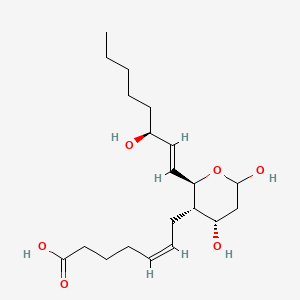Thromboxane b2
Thromboxane b2 is a lipid of Fatty Acyls (FA) class. Thromboxane b2 is associated with abnormalities such as endothelial dysfunction, Diabetes Mellitus, Non-Insulin-Dependent, Diabetes Mellitus, Ischemia and Thrombocytosis. The involved functions are known as Platelet Activation, Excretory function, Anabolism, Inflammation and mRNA Expression. Thromboxane b2 often locates in Endothelium, Hepatic and Microsomes, Liver. The associated genes with Thromboxane b2 are PTGS2 gene, prothrombin fragment 2 and CCL14 wt Allele.
Cross Reference
Introduction
To understand associated biological information of Thromboxane b2, we collected biological information of abnormalities, associated pathways, cellular/molecular locations, biological functions, related genes/proteins, lipids and common seen animal/experimental models with organized paragraphs from literatures.
What diseases are associated with Thromboxane b2?
Thromboxane b2 is suspected in endothelial dysfunction, Diabetes Mellitus, Non-Insulin-Dependent, Diabetes Mellitus, Ischemia, Thrombocytosis, Acute Coronary Syndrome and other diseases in descending order of the highest number of associated sentences.
Related references are mostly published in these journals:
| Disease | Cross reference | Weighted score | Related literature |
|---|
Possible diseases from mapped MeSH terms on references
We collected disease MeSH terms mapped to the references associated with Thromboxane b2
PubChem Associated disorders and diseases
What pathways are associated with Thromboxane b2
There are no associated biomedical information in the current reference collection.
PubChem Biomolecular Interactions and Pathways
Link to PubChem Biomolecular Interactions and PathwaysWhat cellular locations are associated with Thromboxane b2?
Visualization in cellular structure
Associated locations are in red color. Not associated locations are in black.
Related references are published most in these journals:
| Location | Cross reference | Weighted score | Related literatures |
|---|
What functions are associated with Thromboxane b2?
Related references are published most in these journals:
| Function | Cross reference | Weighted score | Related literatures |
|---|
What lipids are associated with Thromboxane b2?
There are no associated biomedical information in the current reference collection.
What genes are associated with Thromboxane b2?
Related references are published most in these journals:
| Gene | Cross reference | Weighted score | Related literatures |
|---|
What common seen animal models are associated with Thromboxane b2?
There are no associated biomedical information in the current reference collection.
NCBI Entrez Crosslinks
All references with Thromboxane b2
Download all related citations| Authors | Title | Published | Journal | PubMed Link |
|---|---|---|---|---|
| Fuchs I et al. | Platelet hyperfunction is decreased by additional aspirin loading in patients presenting with myocardial infarction on daily aspirin therapy. | 2010 | Crit. Care Med. | pmid:20400900 |
| Boizel R et al. | Regulation of oxidative stress and inflammation by glycaemic control: evidence for reversible activation of the 5-lipoxygenase pathway in type 1, but not in type 2 diabetes. | 2010 | Diabetologia | pmid:20535444 |
| Sato R et al. | Inhibition of secretory phospholipase A2 activity attenuates lipopolysaccharide-induced acute lung injury in a mouse model. | 2010 | Exp. Lung Res. | pmid:20426527 |
| Yao HX et al. | [The study of relationship between platelet function and thrombus in patients with essential thrombocythaemia]. | 2010 | Zhonghua Yi Xue Za Zhi | pmid:20356540 |
| Dołegowska B et al. | Dynamics of thromboxane level changes during early phase of allograft reperfusion. | 2009 Sep-Oct | Clin Transplant | pmid:19298388 |
| Tantry US et al. | Aspirin resistance. | 2009 Sep-Oct | Prog Cardiovasc Dis | pmid:19732606 |
| Thomson VS et al. | Aspirin resistance in Indian patients with coronary artery disease and cardiovascular events. | 2009 Oct-Dec | J Postgrad Med | pmid:20083870 |
| Goodman L et al. | Effects of firocoxib and tepoxalin on healing in a canine gastric mucosal injury model. | 2009 Jan-Feb | J. Vet. Intern. Med. | pmid:19175721 |
| Capodanno D and Angiolillo DJ | Platelet monitoring for PCI: which test is the one to choose? | 2009 | Hamostaseologie | pmid:19882078 |
| Gao XR et al. | Efficacy of different doses of aspirin in decreasing blood levels of inflammatory markers in patients with cardiovascular metabolic syndrome. | 2009 | J. Pharm. Pharmacol. | pmid:19903376 |
| Guerrero MD et al. | Anti-inflammatory and analgesic activity of a novel inhibitor of microsomal prostaglandin E synthase-1 expression. | 2009 | Eur. J. Pharmacol. | pmid:19686718 |
| Lowe FJ et al. | Evaluation of biomarkers of exposure and potential harm in smokers, former smokers and never-smokers. | 2009 | Clin. Chem. Lab. Med. | pmid:19676143 |
| Huntjens DR et al. | Differences in the sensitivity of behavioural measures of pain to the selectivity of cyclo-oxygenase inhibitors. | 2009 | Eur J Pain | pmid:18774319 |
| Correa JA et al. | Virgin olive oil polyphenol hydroxytyrosol acetate inhibits in vitro platelet aggregation in human whole blood: comparison with hydroxytyrosol and acetylsalicylic acid. | 2009 | Br. J. Nutr. | pmid:18775097 |
| Hynninen VV et al. | Oral voriconazole and miconazole oral gel produce comparable effects on the pharmacokinetics and pharmacodynamics of etoricoxib. | 2009 | Eur. J. Clin. Pharmacol. | pmid:18777173 |
| Shen H et al. | Aspirin Resistance in healthy drug-naive men versus women (from the Heredity and Phenotype Intervention Heart Study). | 2009 | Am. J. Cardiol. | pmid:19660620 |
| Leoncini G et al. | In retinal vein occlusion platelet response to thrombin is increased. | 2009 | Thromb. Res. | pmid:19660790 |
| Canales A et al. | Platelet aggregation, eicosanoid production and thrombogenic ratio in individuals at high cardiovascular risk consuming meat enriched in walnut paste. A crossover, placebo-controlled study. | 2009 | Br. J. Nutr. | pmid:19068151 |
| Duda MK et al. | Fish oil, but not flaxseed oil, decreases inflammation and prevents pressure overload-induced cardiac dysfunction. | 2009 | Cardiovasc. Res. | pmid:19015135 |
| Lauring B et al. | Laropiprant in combination with extended-release niacin does not alter urine 11-dehydrothromboxane B2, a marker of in vivo platelet function, in healthy, hypercholesterolemic, and diabetic subjects. | 2009 | J Clin Pharmacol | pmid:19833861 |
